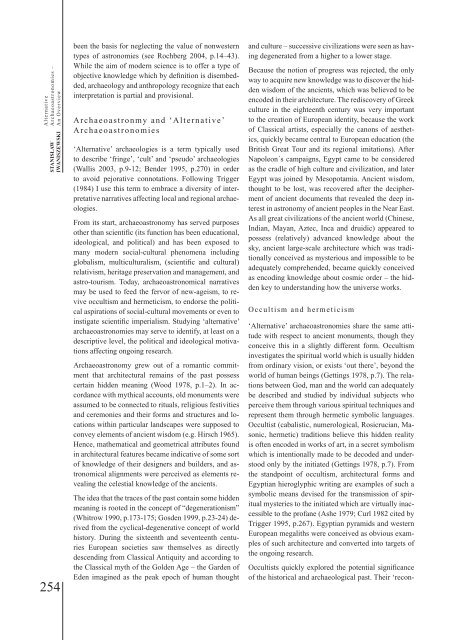BALTICA10
BALTICA10
BALTICA10
Create successful ePaper yourself
Turn your PDF publications into a flip-book with our unique Google optimized e-Paper software.
Alternative<br />
Archaeoastronomies –<br />
An Overview<br />
STANISŁAW<br />
IWANISZEWSKI<br />
254<br />
been the basis for neglecting the value of nonwestern<br />
types of astronomies (see Rochberg 2004, p.14–43).<br />
While the aim of modern science is to offer a type of<br />
objective knowledge which by definition is disembedded,<br />
archaeology and anthropology recognize that each<br />
interpretation is partial and provisional.<br />
Archaeoastronmy and ‘Alternative’<br />
Archaeoastronomies<br />
‘Alternative’ archaeologies is a term typically used<br />
to describe ‘fringe’, ‘cult’ and ‘pseudo’ archaeologies<br />
(Wallis 2003, p.9-12; Bender 1995, p.270) in order<br />
to avoid pejorative connotations. Following Trigger<br />
(1984) I use this term to embrace a diversity of interpretative<br />
narratives affecting local and regional archaeologies.<br />
From its start, archaeoastronomy has served purposes<br />
other than scientific (its function has been educational,<br />
ideological, and political) and has been exposed to<br />
many modern social-cultural phenomena including<br />
globalism, multiculturalism, (scientific and cultural)<br />
relativism, heritage preservation and management, and<br />
astro-tourism. Today, archaeoastronomical narratives<br />
may be used to feed the fervor of new-ageism, to revive<br />
occultism and hermeticism, to endorse the political<br />
aspirations of social-cultural movements or even to<br />
instigate scientific imperialism. Studying ‘alternative’<br />
archaeoastronomies may serve to identify, at least on a<br />
descriptive level, the political and ideological motivations<br />
affecting ongoing research.<br />
Archaeoastronomy grew out of a romantic commitment<br />
that architectural remains of the past possess<br />
certain hidden meaning (Wood 1978, p.1–2). In accordance<br />
with mythical accounts, old monuments were<br />
assumed to be connected to rituals, religious festivities<br />
and ceremonies and their forms and structures and locations<br />
within particular landscapes were supposed to<br />
convey elements of ancient wisdom (e.g. Hirsch 1965).<br />
Hence, mathematical and geometrical attributes found<br />
in architectural features became indicative of some sort<br />
of knowledge of their designers and builders, and astronomical<br />
alignments were perceived as elements revealing<br />
the celestial knowledge of the ancients.<br />
The idea that the traces of the past contain some hidden<br />
meaning is rooted in the concept of “degenerationism”<br />
(Whitrow 1990, p.173-175; Gosden 1999, p.23-24) derived<br />
from the cyclical-degenerative concept of world<br />
history. During the sixteenth and seventeenth centuries<br />
European societies saw themselves as directly<br />
descending from Classical Antiquity and according to<br />
the Classical myth of the Golden Age – the Garden of<br />
Eden imagined as the peak epoch of human thought<br />
and culture – successive civilizations were seen as having<br />
degenerated from a higher to a lower stage.<br />
Because the notion of progress was rejected, the only<br />
way to acquire new knowledge was to discover the hidden<br />
wisdom of the ancients, which was believed to be<br />
encoded in their architecture. The rediscovery of Greek<br />
culture in the eighteenth century was very important<br />
to the creation of European identity, because the work<br />
of Classical artists, especially the canons of aesthetics,<br />
quickly became central to European education (the<br />
British Great Tour and its regional imitations). After<br />
Napoleon´s campaigns, Egypt came to be considered<br />
as the cradle of high culture and civilization, and later<br />
Egypt was joined by Mesopotamia. Ancient wisdom,<br />
thought to be lost, was recovered after the decipherment<br />
of ancient documents that revealed the deep interest<br />
in astronomy of ancient peoples in the Near East.<br />
As all great civilizations of the ancient world (Chinese,<br />
Indian, Mayan, Aztec, Inca and druidic) appeared to<br />
possess (relatively) advanced knowledge about the<br />
sky, ancient large-scale architecture which was traditionally<br />
conceived as mysterious and impossible to be<br />
adequately comprehended, became quickly conceived<br />
as encoding knowledge about cosmic order – the hidden<br />
key to understanding how the universe works.<br />
Occultism and hermeticism<br />
‘Alternative’ archaeoastronomies share the same attitude<br />
with respect to ancient monuments, though they<br />
conceive this in a slightly different form. Occultism<br />
investigates the spiritual world which is usually hidden<br />
from ordinary vision, or exists ‘out there’, beyond the<br />
world of human beings (Gettings 1978, p.7). The relations<br />
between God, man and the world can adequately<br />
be described and studied by individual subjects who<br />
perceive them through various spiritual techniques and<br />
represent them through hermetic symbolic languages.<br />
Occultist (cabalistic, numerological, Rosicrucian, Masonic,<br />
hermetic) traditions believe this hidden reality<br />
is often encoded in works of art, in a secret symbolism<br />
which is intentionally made to be decoded and understood<br />
only by the initiated (Gettings 1978, p.7). From<br />
the standpoint of occultism, architectural forms and<br />
Egyptian hieroglyphic writing are examples of such a<br />
symbolic means devised for the transmission of spiritual<br />
mysteries to the initiated which are virtually inaccessible<br />
to the profane (Ashe 1979; Curl 1982 cited by<br />
Trigger 1995, p.267). Egyptian pyramids and western<br />
European megaliths were conceived as obvious examples<br />
of such architecture and converted into targets of<br />
the ongoing research.<br />
Occultists quickly explored the potential significance<br />
of the historical and archaeological past. Their ‘recon-
















